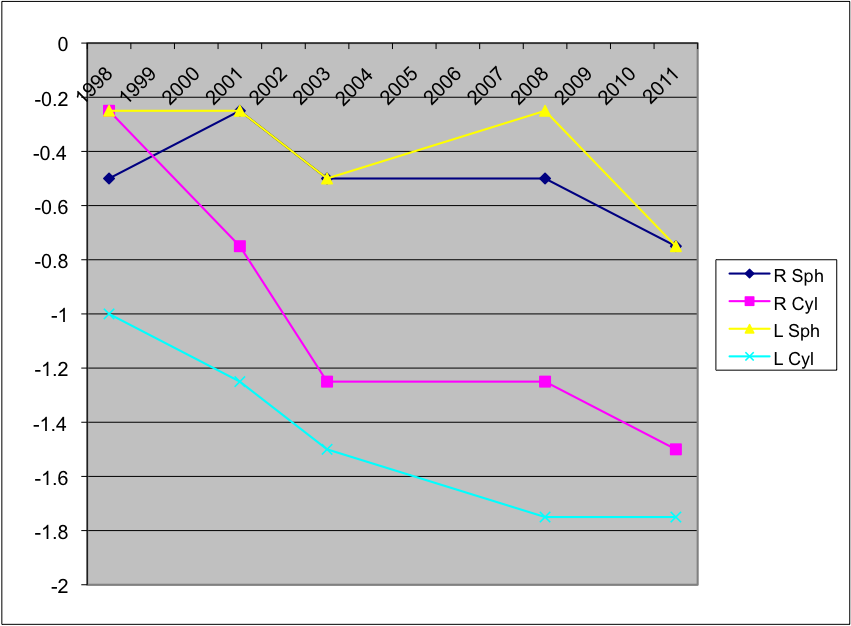Cracking the optometry code
March 25th, 2011 at 5:34 pm (Medicine, Vocabulary)
Have you ever wondered what a diopter is? After my most recent trip to the optometrist, I decided to find out what an eyeglass prescription means.
Wikipedia, as usual, is a great place to start. At a high level, the “spherical” correction number indicates how much isotropic correction is needed — magnification that applies equally in all directions. The “cylindrical” correction applies to astigmatisms, which require magnification preferentially in one direction to fine-tune the spherical correction. “Axis” specifies the orientation of that cylindrical correction.
The units in which the spherical and cylindrical corrections are specified are called diopters. A diopter has a physical meaning; it is the reciprocal of the focal length in meters. So a spherical correction of -0.50 corresponds to a lens with a focal length of 2 m.
I collected my prescriptions since 1998, when I first got glasses. Now I can track my visual degradation graphically (except for an elusive 2006 prescription, which I cannot find — argh!):

Apparently my distance vision isn’t terrible (something like 20/50), but my astigmatism is what causes me blurring trouble, and it keeps getting worse. Next up: a regression analysis in which I forecast the date on which I’ll be legally blind!
Wikipedia also includes an interesting discussion of presbyopia, the gradual decline in ocular lens flexibility. This is what permits your eye to focus over a wide range of distances. Children generally can accommodate a range of more than 10 diopters, while those older than 50 can only accommodate 2. Check out this plot:

Wikipedia claims that kids can focus on something only 10 cm (~4 inches) from their eyes. Can you? Try it! (I can’t, darn!) This calculator purports to determine how much reading-glass (near-vision) correction you would need, as a function of your age; unfortunately, it only works if you’re at least 37.
As an interesting etymological note, the root “presby-” in presbyopia means “old” or “elder” (i.e., presbyopia = elder-eye), and is the same root in “priest” (“presbyter”) and “presbyterian.”
Myra said,
March 25, 2011 at 7:10 pm
You are just so awesome. Can I marry you?
Scott and I were just at the optometrist today where I was told I was experiencing presbyopia. I didn’t tie it to the fact I am a (lapsed) Presbyterian.
I am feeling a bit bummed about my middle-age status and progressive lenses though. I thought I’d be at least 40 before I’d need bifocals.
Mike said,
March 26, 2011 at 3:09 pm
My students are dealing with lenses and mirrors right now, and in my office hours on Wednesday they asked about the correlation to prescription glasses and contact lenses! I also didn’t know about the focusing distance of children, but my closest was about 12.7 cm.
Lukas Mandrake said,
March 12, 2017 at 5:03 pm
So beautifully succinct as always. All of us should be able to trivially see our own medical information over time with the click of a button. Even doctors don’t often bother to use this powerful perspective.
Btw my kids used to smash things in my face and say “Look at this!” I always assumed it was lack of social barriers and a model of what another person can see, until I learned how closely young children can in fact focus. They’re like little magnifying glasses. Absolutely amazing.
My brain. New body. Young. ‘Nuff said. Get this done, medicine. I got around twenty to forty more years to wait.